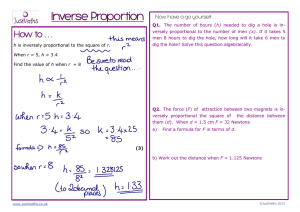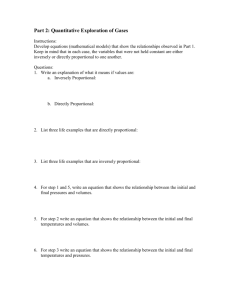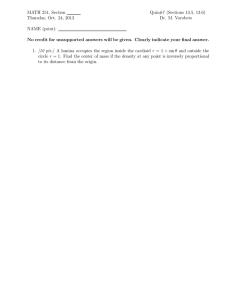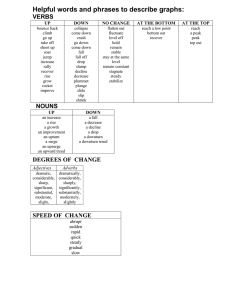MATH 116 Inversely Proportional Functions
advertisement
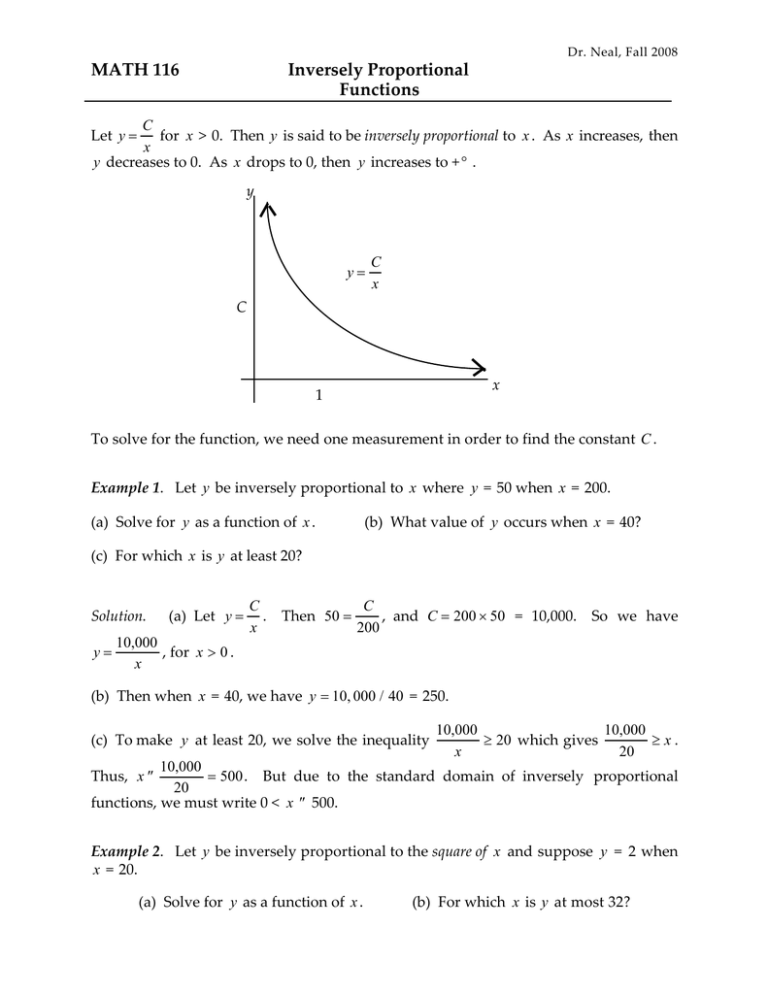
Dr. Neal, Fall 2008 MATH 116 Inversely Proportional Functions C for x > 0. Then y is said to be inversely proportional to x . As x increases, then x y decreases to 0. As x drops to 0, then y increases to +∞. Let y = y y= C x C x 1 To solve for the function, we need one measurement in order to find the constant C . Example 1. Let y be inversely proportional to x where y = 50 when x = 200. (a) Solve for y as a function of x . (b) What value of y occurs when x = 40? (c) For which x is y at least 20? Solution. y= (a) Let y = C C . Then 50 = , and C = 200 × 50 = 10,000. So we have x 200 10,000 , for x > 0 . x (b) Then when x = 40, we have y = 10, 000 / 40 = 250. (c) To make y at least 20, we solve the inequality 10,000 10,000 ≥ 20 which gives ≥x. x 20 10,000 = 500. But due to the standard domain of inversely proportional 20 functions, we must write 0 < x ≤ 500. Thus, x ≤ Example 2. Let y be inversely proportional to the square of x and suppose y = 2 when x = 20. (a) Solve for y as a function of x . (b) For which x is y at most 32? Dr. Neal, Fall 2008 C C 800 Solution. (a) Let y = 2 . Then 2 = 2 andC = 2 × 20 2 = 800. Thus y = 2 for x > 0 . x 20 x (b) To make y at most 32, we solve the inequality 800 800 2 2 ≤ 32 which gives 32 ≤ x . x 800 Thus, x 2 ≥ = 25. Taking the square root, we have x ≥ 5. 32 Example 3. At a fixed temperature, gas pressure P is inversely proportional to container volume V . Suppose that for a volume of 12 liters, the pressure is 4.5 psi . (a) (b) (c) (d) Find the pressure P as a function of volume V for this temperature. What happens to the pressure as volume decreases? What is the pressure for a volume of 15 liters? What volumes gives a pressure of at least 8 psi? Solution. (a) Let P = C C 54 . Then 4.5 = , so C = 4.5 × 12 = 54. Thus, P = for V > 0. V 12 V (b) As the volume decreases (to 0), the pressure goes up. (c) For V = 15 liters, then P = (d) Solve 54 = 3.6 psi. 15 54 54 ≥ 8, which gives ≥ V . Thus we must have 0 < V ≤ 6.75 liters. V 8 Exercise For objects moving in circles at a constant speed, the angular velocity is inversely proportional to the radius r . (The angular velocity measures how fast your angle is rotating as you move.) Suppose a radius of 10 miles gives an of 15º per hour. (a) (b) (c) (d) (e) Find as a function of r . What is for a 5 miles radius? What is for a 20 mile radius? What happens to as r increases? What radii make more than 5º per hour? What radii make at most 50º per hour? Dr. Neal, Fall 2008 Solution (a) Let = C C . Then 15 = and C = 150 . So r 10 (b) For r = 5 miles, = = 150 for r > 0. r 150 = 30º per hour. For r = 20 miles, 5 = 150 = 7.5º per hour. 20 (c) decreases as r increases (Your angle moves more slowly as the radius increases provided the linear speed stays the same.) (d) Solve 150 > 5 to obtain 30 > r . So we must have 0 < r < 30 miles . r (e) Solve 150 ≤ 50 to obtain 3 ≤ r . So for r ≥ 3 miles, we have r ≤ 50º per hr.
